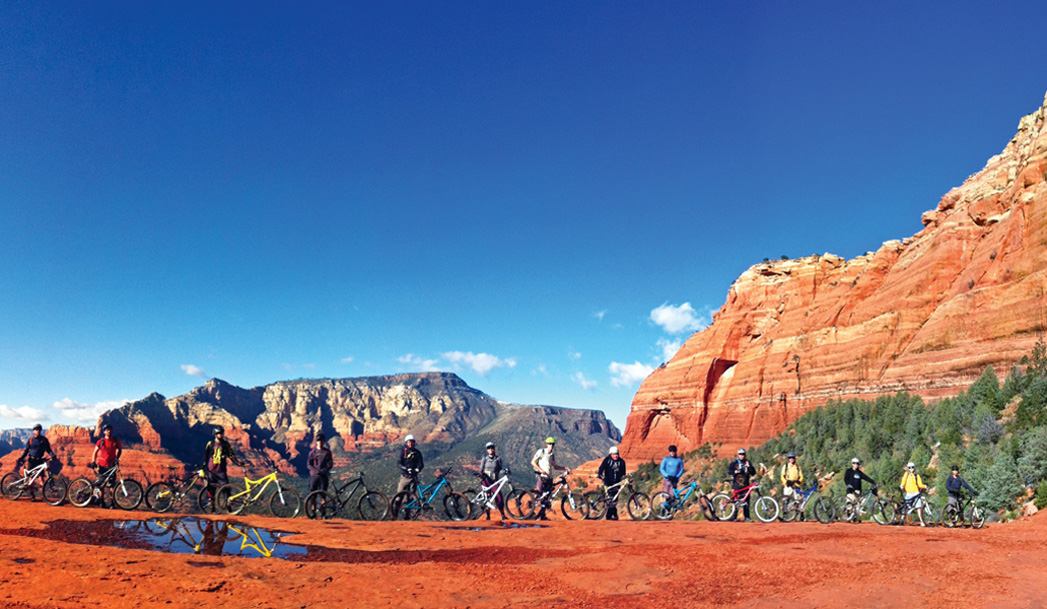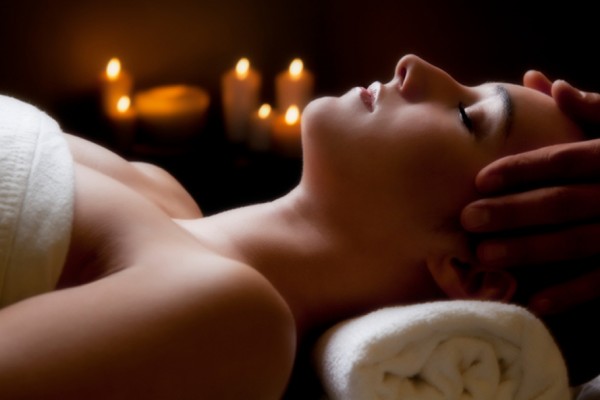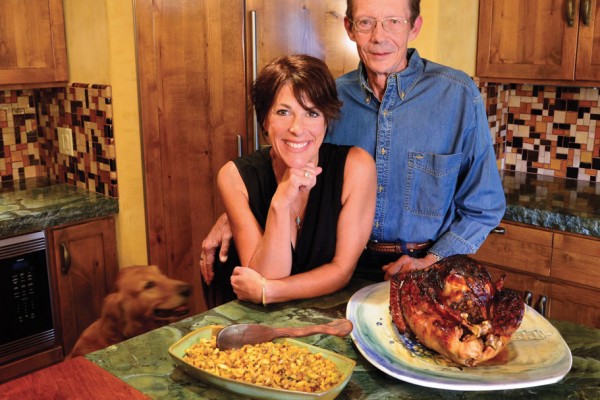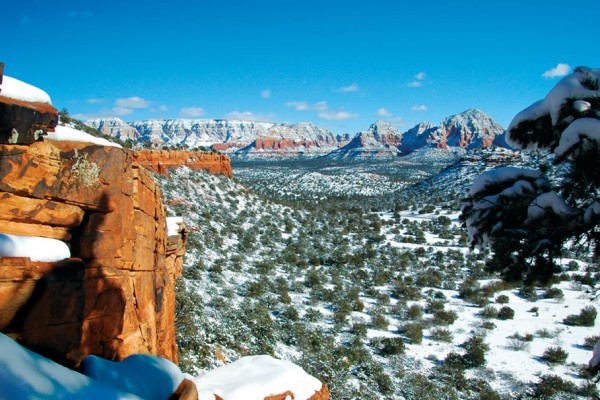The popularity of mountain biking in Red Rock Country over the last 10 years has exploded, and it shows no signs of slowing down. On any given weekend you will see large vans parked at local bike shops, demoing and testing the latest and greatest equipment. Professional riders come from all over the country to train here in the winter. Bike Magazine’s popular January/February issue, The Bible of Bike Tests, was photographed in Sedona in 2014. The Village of Oak Creek boasts a hotel that caters to mountain bikers, Red Agave Resort, where enthusiasts are welcome to bring their bikes into their rooms and can hit trails right from the hotel’s front door. West Sedona School offers the Wildcat Mountain Bike Club with approximately 40 members, and Sedona Red Rock High School has a mountain bike team. The city even has plans for the Sedona Bike Skills Park, which will be located on 13 acres of land within Posse Grounds Park in West Sedona. (As of press time, the park was in the design stages.) And since 2009, Coconino National Forest has added 50 miles of trails, all open to mountain bikes.
Rewind the narrative 10 years, and this wasn’t necessarily the case. Though mountain bikers have been traversing the red rocks for at least 20 years (Lars Romig, president of the Verde Valley Cyclists Coalition, says Trek Bicycle Corporation came out with a mountain bike called “Sedona” in the early 1990s), Sedona was more of a secret destination. “When I moved to Sedona 11 years ago, mountain biking was more of an underground activity,” says Steve McClain, store manager for Absolute Bikes Sedona. Steve has been in the industry since 1975; he says he saw his first mountain bike in Bloomington, Indiana, in 1980. “Today, the forest service is very pro-mountain bikes, and there’s been a huge increase in trails – probably twice as many as there were 10 years ago.”
Mountain bikers who’ve been in the area for a long time will also tell you that the community was frequently at odds with the forest service. And then there was the issue of illegal trail building. It’s true that many of those “social trails” have been adopted by the forest service, thus the 50 miles of additional paths. Some of those trails have seen major reroutes in order to protect resources, says Jennifer Burns, recreation staff officer for the Red Rock Ranger District of the Coconino National Forest. Jennifer is quick to point out that it’s not only bikers creating social trails – there are plenty forged by hikers and equestrians. She says many of the social paths demonstrated a need for more loop and connector trails.
“There was a lot of merit to some of these routes,” says Jennifer, who hikes and bikes. “There are some people out there who say we shouldn’t entertain bringing any of those trails into our system, but I don’t think a blanket statement is very helpful. I say we need to look at each trail individually. The new trail system is catching up to what this area needs. Our trail system is our best tool for protecting our resources. Our goal is to allow people to experience the forest.”
How many traverse our trails each year? According to Jennifer, the official number is 800,000 “uses” by hikers, bikers and equestrians, though she believes that number to be much closer to 1 million. Eighty-two percent of users are hikers while 17 percent are bikers, and 1 percent are equestrians. “When we shared those numbers with Washington, D.C. they were shocked,” says Jennifer. Trail use has increased every year, even during the recession. Red Rock Country includes 250 miles of trails; 25 miles of those trails are located in designated wilderness areas, which means mountain bikes are not permitted.
Since the adoption program began in 2009 with Pigtail Trail near SR 179, Jim Monahan, who has owned Sedona Bike & Bean in the Village of Oak Creek for 10 years, says he hasn’t heard of any new “secret” trails being constructed. “Hikers and bikers are out there self-policing,” he says. Mike Raney, who co-owns Over the Edge in West Sedona along with Jason First, says the majority of riders aren’t looking for secret trails. “When you have a short amount of time to ride, you don’t want to run the risk of getting lost,” he says. “You want to get out there and have a good time.” (Jennifer notes that hikers and bikers becoming lost or getting hurt on social trails was a serious problem, which is why the forest service has also beefed up signage on all trails.)
Mountain bikers all have their personal favorite trails, but the two that come up most often are Hiline, near Castle Rock in the Village of Oak Creek, and Hangover Trail on Schnebly Hill Road. The Hogs Trails in the Broken Arrow area and Chuck Wagon Trail on Long Canyon Road are both close seconds. The bike shops and area visitors centers can provide maps of the trails. Everyone agrees that most of Sedona’s trails are geared toward intermediate or advanced riders. For entry-level riders, Bell Rock Pathway is often recommended. Jennifer says easier trails are in the works for the area surrounding Yavapai College Sedona Center in West Sedona.
So where does Sedona rank on the list of mountain bike destinations in North America? Everyone points to Moab, Utah, as the mountain bike capital of the U.S., and there’s no doubt it is a much larger area than Sedona. Jennifer says Moab includes 8 million acres for recreating while Sedona has 60,000 acres. Jim says that Moab is part of a circle in the Southwest that includes Sedona and Flagstaff in Arizona, Moab and Brian Head in Utah and Grand Junction in Colorado. “It’s about a 7-hour-drive-time circle around Sedona, and people come out and hit up all of these all of the time,” he says. But Sedona has one major benefit that Moab lacks, says Mike: accessibility.
“In Moab, trails are as far as 10 miles from the bike shops and the town,” says Mike. “The easy access to the forest here is unbelievable. I’ve traveled the world riding, and this is still my favorite place, hands down. You can go out on your lunch break and ride in a world-class destination – no problem.”
The four bike shops in town seem to have a good rapport. All four are participating in the Sedona Mountain Bike Festival this month (see sidebar on page 38). Shop owners and employees donate time and money to trail maintenance, and they go on group rides together. (Sedona Bike & Bean hosts a popular group ride every Friday afternoon followed by beer and pizza at the shop. The ride is open to everyone and has been known to attract up to 30 people.) Shop owners also share many of the same theories as to why mountain biking in Sedona has become so popular. Mike says Sedona’s demographic is getting younger and more adventurous. Dave Cichan, owner of The Fat Tire Bike Shop, says the trails here are challenging, which keeps people returning to the area again and again. Steve praises the beauty and year-round good weather, and Jim says the recent influx of media coverage brings people to the area. “Every outdoor publication out there is talking about Sedona,” he says.
All of those visitors add up to dollars for the local economy, especially when you consider the cost of a mountain bike, which can range in the thousands. Jim says on a recent group ride, the least expensive bike was $4,000. “There used to be this image of a rogue, 18-year-old mountain biker,” he says. “In reality, he’s a 40-year-old professional with a $7,000 bike who’s going to stay in Sedona for a week.”
Though the Sedona Chamber of Commerce doesn’t separate biking and hiking in its visitor surveys, Jennifer Wesselhoff, president and CEO, says there’s no doubt mountain bike tourism benefits the economy. An outdoor recreation economy report written by the Outdoor Industry Association in 2012 says Americans spend more on bicycling gear and trips ($81 billion) than they do on airplane tickets and fees ($51 billion). Jennifer says more than 50 percent of Sedona visitors hike and/or bike during their visit. “Mountain biking has been a key component to our destination marketing strategy over the last three years,” she says.
All of this adds up to good news for Sedona and the surrounding forest, says Jennifer Burns. “Our trail system is a fundamental way that we enjoy the surrounding national forest,” she says. “That is true for many users: bikers, hikers, spiritual seekers, etc. Because of this, our future trail system will continue to be one where we all need to share this incredible resource. The future of our trail system and our access to it rests with all of us doing our part to be responsible trail users.”
MORE SEDONA ADVENTURES AND SPORTS: Helicopter, hot Air balloon and biplane tours, skiing, snowboarding and ice skating, hiking, biking, rock climbing and backpacking, baseball, golf




